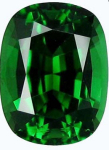Chrome Tourmaline
Tourmaline Gemstone Properties
Tourmaline gemstones, the birthstone for October come in a rainbow of color , tones and hues. In fact it is sometimes referred to as the “gemstone of the rainbow”. There are actually ten separate mineral species in the tourmaline gemstone group, of which only three are suitable as gemstones.
Tourmaline gemstones, the birthstone for October come in a rainbow of color , tones and hues. In fact it is sometimes referred to as the “gemstone of the rainbow”. There are actually ten separate mineral species in the tourmaline gemstone group, of which only three are suitable as gemstones.
The elbaite species is the one that is most often used for creating beautiful jewelry. The color in tourmaline is a result of substitutions of various transition elements or metals in the crystal structure. Rarely can one find a tourmaline crystal with a single color, most tourmaline crystals are found with numerous colors.
Tourmaline is a very dichroic gemstone, meaning that colors look more or less intense depending on the viewing angle. This presents challenges to the gemstone cutter when orienting the gemstone for best color. Tourmaline is a fairly hard (7-7.5 on Mohs scale) and mostly durable gemstone.
Some tourmalines can crack or become unstable due when faceted or heat treated. Color can and may be improved by heat treatment and/or irradiation. These treatments are permanent and generally accepted in the gemstone trade if properly disclosed. Tourmaline also possesses the interesting electrical phenomenon of piezoelectricity.
Tourmaline Gemstone History and Lore
The first confirmed use of tourmaline is by the Greeks, who imported the gem from Asia in the second century BC. In the sixteenth century, Portuguese explorers though they had discovered emeralds when it was really green tourmaline.
Tourmaline Gemstone History and Lore
The first confirmed use of tourmaline is by the Greeks, who imported the gem from Asia in the second century BC. In the sixteenth century, Portuguese explorers though they had discovered emeralds when it was really green tourmaline.
The word tourmaline is derived from the Sinhalese word "tora malli", which refers to any unidentified yellow, green or brown stone and literally means "something out of the earth". In 1822 red and green tourmaline was discovered in Maine and, as this new source produced sufficient quantities of gemstones, a new market was created and gave tourmaline value. During this time Maine and California were the world’s largest producer of gem tourmalines.
Tourmaline Gemstone Sources and Occurrences
Tourmaline is the most common boron bearing silicate mineral and is almost exclusively found in geological formations known as pegmatites. Brazil is the world's largest producer of gem quality tourmaline.
Tourmaline Gemstone Sources and Occurrences
Tourmaline is the most common boron bearing silicate mineral and is almost exclusively found in geological formations known as pegmatites. Brazil is the world's largest producer of gem quality tourmaline.
In recent years, African nations of Zambia, Madagascar and Mozambique have also produced enormous quantities of gem grade material. The most exciting discovery of a new gem variety of tourmaline was made in the early 1990's when a neon blue colored tourmaline started to appear from the state of Paraiba Brazil.
This gem displays amazing blue and green colors unlike anything ever seen in tourmalines. As the only mine has dried up in recent years, prices for these extraordinary gems have reached astronomical levels of up to $15,000/ct wholesale! Another very exciting tourmaline gemstone discovery occurred in Mozambique in the past 2 years. Copper bearing tourmaline with colors similar to the famous Paraiba tourmalines from Brazil began appearing in the gemstone markets. Although not quite as intense and vivid as the Paraiba’s from Brazil, these new tourmalines are being called Paraibia tourmaline.
Tourmaline Gemstone Evaluation and Valuation
Like most colored gemstones, tourmalines are evaluated by the purity and intensity of color. Clarity is an important factor in almost all tourmalines except Rubellite and Paraiba varieties.
Like most colored gemstones, tourmalines are evaluated by the purity and intensity of color. Clarity is an important factor in almost all tourmalines except Rubellite and Paraiba varieties.
The most valued of tourmalines is the Paraiba tourmaline by far. Any intense, vivid “Windex” blue gemstone commands a terrific price. Rubelite, fine blue tourmalines (Indicolites), blue/green, and bi-color and parti color can also command good prices. Values are not affected by permanent treatments such as heat and irradiation.
When you are ready to order contact us at gems4u@rocketmail.com and we will find any gem you want. These gems used to be cheap a few years back but now are getting harder to find each year and the price goes up as well all the time. So grab one now.
Have a good New Year
Gregg
